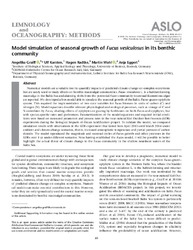Model simulation of seasonal growth of Fucus vesiculosus in its benthic community
DOI: https://doi.org/10.1002/lom3.10351
Persistent URL: http://resolver.sub.uni-goettingen.de/purl?gldocs-11858/9312
Persistent URL: http://resolver.sub.uni-goettingen.de/purl?gldocs-11858/9312
Graiff, Angelika; Karsten, Ulf; Radtke, Hagen; Wahl, Martin; Eggert, Anja, 2020: Model simulation of seasonal growth of Fucus vesiculosus in its benthic community. In: Limnology and Oceanography: Methods, Band 18, 3: 89 - 115, DOI: 10.1002/lom3.10351.
 |
Dokument öffnen: |
Numerical models are a suitable tool to quantify impacts of predicted climate change on complex ecosystems but are rarely used to study effects on benthic macroalgal communities. Fucus vesiculosus L. is a habitat-forming macroalga in the Baltic Sea and alarming shifts from the perennial Fucus community to annual filamentous algae are reported. We developed a box model able to simulate the seasonal growth of the Baltic Fucus–grazer–epiphyte system. This required the implementation of two state variables for Fucus biomass in units of carbon (C) and nitrogen (N). Model equations describe relevant physiological and ecological processes, such as storage of C and N assimilates by Fucus, shading effects of epiphytes or grazing by herbivores on both Fucus and epiphytes, but with species-specific rates and preferences. Parametrizations of the model equations and required initial conditions were based on measured parameters and process rates in the near-natural Kiel Outdoor Benthocosm (KOB) experiments during the Biological Impacts of Ocean Acidification project. To validate the model, we compared simulation results with observations in the KOB experiment that lasted from April 2013 until March 2014 under ambient and climate-change scenarios, that is, increased atmospheric temperature and partial pressure of carbon dioxide. The model reproduced the magnitude and seasonal cycles of Fucus growth and other processes in the KOBs over 1 yr under different scenarios. Now having established the Fucus model, it will be possible to better highlight the actual threat of climate change to the Fucus community in the shallow nearshore waters of the Baltic Sea.
Statistik:
ZugriffsstatistikSammlung:
This is an open access article under the terms of the Creative Commons Attribution-NonCommercial-NoDerivs License, which permits use and distribution in any medium, provided the original work is properly cited, the use is non-commercial and no modifications or adaptations are made.

